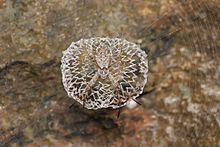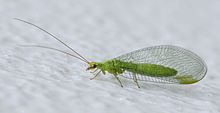It’s another Orb Weaver spider that makes the web in the evening and eats it by the morning.
It’s a distinctive ‘X’ pattern that the spider makes.
What does it make it, I’m not very sure.
It’s another Orb Weaver spider that makes the web in the evening and eats it by the morning.
It’s a distinctive ‘X’ pattern that the spider makes.
What does it make it, I’m not very sure.
Orb-weaver spiders or araneids are members of the spider family Araneidae . They are the most common group of builders of spiral wheel-shaped webs often found in gardens, fields and forest. “Orb” can in English mean “circular”, hence the English name of the group. Araneids have eight similar eyes, hairy or spiny legs, and no stridulating organs.
The family is cosmopolitan, including many well-known large or brightly colored garden spiders. With 3122 species in 172 genera worldwide, Araneidae is the third-largest family of spiders (behind Salticidae and Linyphiidae). Araneid webs are constructed in a stereotyped fashion. A framework of nonsticky silk is built up before the spider adds a final spiral of silk covered in sticky droplets.
The spider that we saw earlier which is the Telamonia dimidiata
also belongs to the Order: Araneae
Quite interesting!!
Some pictures that I saw on the net…
Thought of sharing it here

 Araneidae family web
Araneidae family web
@singh
The photos you have taken are marvellous. I know some things about spiders. Spider is considered as tiger in microhabitat and there are so many new species of spiders are discovered in India. A new species also discovered in Aarey Colony in Mumbai. Sadly, there were efforts to destroy the forest. But, thanks to the people who fought against the move and there is not any measures of destruction of Aarey as of now. The research in India on spiders is very low even though there are reports of discovering new species of spiders in India.
That X thing is called Stabilimentum. The genus that spider belongs to is Argiope.
I have taken these screenshots of the above articel for your question about “why do they do X?” I recommend to read that article if you wish to know more about Argiope. It is very good article I found from the lot of available ones on Internet.
There is a dedicated website for helping in the identification of species of spider. We can also search the spider and figure out its classification by its colour on this website.
The interesting fact about spiders is in the most of the species of spiders, females are larger than males. The babies of the spider are called spiderlings. And the wolf spider carries its spiderlings on its back and I saw this video of that spider on one of the infotainment channel. The video was amazing.
Found an interesting creature in my washroom today ![]()
Though the topic is beautiful insects in my garden…this is a beautiful insect in the washroom that I saw ![]()
Looking at it,
Of course its an animal belonging to animalia kingdom.
Its body has the 3 divided parts; head, thorax & abdomen.
Hence, an arthropod
Has a pair of antennae, 3 part body, 3 pairs of jointed legs (6 legs) which tells that its an insect
Four membranous wings, all about the same size, with many veins. They have chewing mouthparts…these are the characteristics of Order: Neuroptera
This matches with the insect that I found.
I got a picture of the same insect that I saw in the internet.
As soon as I searched for Neuroptera on the internet,
I saw this ![]()
I was like wooww…I found it…I found out which insect it is…I was happy!!!
I thought of moving ahead with the classification.
This is a Green lacewing insect in the large family of Chrysopidae
Chrysopa is a genus of green lacewings in the neuropteran family Chrysopidae.

The genus is Chrysopa
Species: Chrysopa pallens
Haven’t got any characteristics of the genus and the specie of this insect
Need help from others for finding out about this species…
And also want help from everyone for making sure that this is the species insect that I saw.
@singh @Pritika @Venkat
A cute looking insect ![]()
![]()
![]()
Looked very colourful and attractive to my eyes!..
Found another creepy crawly on the floor.
Google lens says its a house centipede
I was afraid but this link says we shouldn’t kill them.
Good picture!
Every part of this creature is visible clearly .
This house centipede looks quite dangerous…
Would end up killing it… ![]()
Why should we not kill them?
The link that you shared gives the following explanation for not killing them!
But it does carry venom on its 2 legs near the head.
Won’t that be dangerous for us, if we are stung?
Look at it from the insect’s view point:
I don’t want to waste my precious little venom on a human whom I can’t eat or kill.
Let me save venom and use it for something useful like digesting food and killing it.
Let me hide and stay away from humans so that I live long.
But if a human starts to handle me, try to catch me with hands, may be, I’ll hold my ground and strike back but only in self defense and as a last resort.
Very true Sir…
I got your point
Found a Handmaiden Moth lurking around my house. It was relishing on a sweet chutney that had accidentally fallen on the carpet.
Great Shot sir! @singh sir! How is a moth different from a butterfly? ![]() Did this moth have only a pair of wings?
Did this moth have only a pair of wings?
Quite an interesting name of this moth!!
Is there anything interesting in this moth because of its name?
The scientific name of this moth is Syntomoides imaon.
Syntomoides imaon , the handmaiden moth , is a moth… It was described by Pieter Cramer in 1780. It is well distributed in Sikkim, Khasi hills and throughout India Kerala, Sri Lanka, Myanmar, Bangladesh and Hong Kong.
Good to have @yash_sheregare joining us here in the discussion…keep continuing!!
Not sure technically, but as per Wikipedia:
Although the rules for distinguishing moths from butterflies are not well established, one very good guiding principle is that butterflies have thin antennae and (with the exception of the family Hedylidae) have small balls or clubs at the end of their antennae. Moth antennae are usually feathery with no ball on the end. The divisions are named by this principle: “club-antennae” (Rhopalocera) or “varied-antennae” (Heterocera).
Yes. It had only one visible pair. Initially I thought it was a wasp of some kind. But it turned out to be a moth.
According to the given below article, butterfly’s antennae are club-shaped with long shaft and bulb at the end, and moth’s antennae are feathery or saw-edged.
Found another beautiful creature, a Melon Fly, at least, google lens thinks it is. It has beautiful transparent wings. I was immediately drawn to it.
Found a lovely jumper spider.
I have seen the retina of cats and dogs glow in the dark.
But it’s the first time I am looking at the retinal reflection of a spider
To fix this, please try to reduce the size of the file below 1MB.
The same problem was faced by me earlier, but when I tried uploading files below 1MB (by reducing the size of the photo or video).
Give it a try!
@singh
This spider is furry…right!?
What’s the size of this spider?